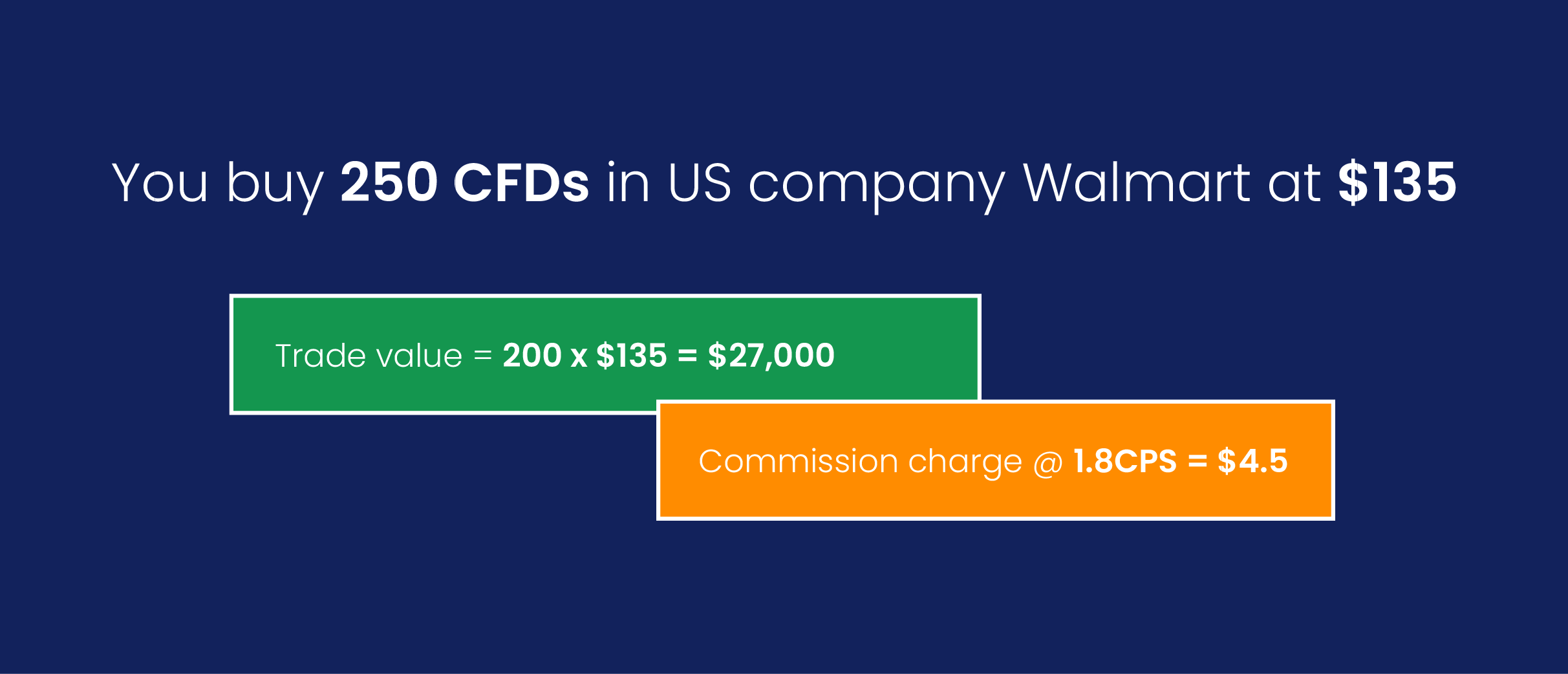Mastering CFDs
CFD trading costs
Learn about CFD costs here, including when you’ll pay CFD commission, which markets are free of commission, how overnight financing works and more.
CFD commission vs the spread
There are two ways to be charged when you open or close a CFD trade, either a commission or through the spread. Which method you’ll use depends on the asset class you’re trading:
- Indices and commodities are commission free. You only pay the spread on these markets
- Stock CFDs are subject to commission charges. This commission charge is based on the overall value of the trade
What is CFD commission?
CFD commission is typically charged when opening and closing a contract for difference (CFD) position on equities. The amount of commission you’ll pay depends on where you share is listed. There is also a minimum commission charge in place. For most equities, the charges are as follows:
| MARKET NAME | COMMISSION PER TRADE |
|---|---|
| UK Stocks | 0.08% (£10 minimum) |
| European Stocks | 0.08% (€10 minimum) |
| US Stocks | 1.8CPS ($10 minimum) |
You can also find commission details for any asset on the Market 360 tab in the FOREX.com platform.
CFD commission example
Say, for instance, that you want to buy 250 Walmart CFDs when the stock is at $135. The total value of your position is (200 * $135) $27,000, and Walmart has a commission of 1.8CPS, so you’d pay (1.8 *250), or $4.5. Since this is under the minimum, you would pay the $10 minimum commission.

Spreads with CFDs
FOREX.com quotes a two-way price on all our markets, a bid price and an ask price.
- You trade at the bid to sell a market
- You trade at the ask to buy a market
The spread is the difference between the sell and the buy prices. On commission-free asset classes, the spread is in effect your cost of trading the market. The tighter the spread, the quicker the trade can potentially move into profit-earning territory.
On stock CFDs, the spread simply reflects the difference between the buy and sell prices of the underlying market.
Overnight CFD financing
Overnight financing is a charge that you pay to hold a CFD position open for more than a single day. Essentially, it is an interest payment to cover the cost of the leverage that you use overnight. You may also see this referred to as your cost of carry.
There is no financing charge for CFDs with expiry dates (forwards). Instead, these contracts have wider spreads as the cost of carry has been incorporated into the price.
Overnight financing is charged at the relevant base rate of your instrument +2.5% on long positions. You will alternatively ‘receive’ the rate -2.5% on short positions. The percentage will be calculated based on the size of your trade at end of the day, and divided by 365 to get a daily rate.
These are the rate benchmarks for markets in priced EUR, GBP, JPY, SGD and USD:
| CURRENCY | BENCHMARK |
|---|---|
| EUR | €STR |
| GBP | SONIA |
| JPY | TONAR |
| SGD | SORA |
| USD | SOFR |
However, when underlying interest rates are low, a daily financing fee is charged rather than paid to you on short positions.
CFD financing example
You decide to buy three CFDs on the UK 100 at 7310. The trade is doing well and its price has increased to 7340 by the end of the day. However, it is still some way from your target price of 7380. You decide to keep the position open overnight.
The value of your position at close is (7340 * 3) 22,020. To calculate your overnight financing, you add 2.5% to the current SONIA rate, multiply that percentage by 22,020, then divide that figure by 365.
If SONIA is 0.25%, then:
- 0.25% + 2.5% is 2.75%
- 2.75% * 22,020 is 605.55
- 605.55/365 is £1.65
- Your overnight financing charge is £1.65, converted to the base currency of your account
Rolling CFD futures
When futures contracts are near to expiry, you can, if you wish, roll your trade into the following contract. You can do this by selecting the auto–roll tick box in the order ticket. You’ll pay half the spread to carry out this transaction.
- If you’re going long, your position will be closed at the mid-price and re-opened in the next contract at the buy price
- If you’re going short, your position will be closed at the mid-price and opened again at the sell price in the following month
It’s cheaper to roll over to the next contract than to close the trade yourself and then reopen it. This is because when closing and opening a trade manually, you pay the full spread, whereas by "rolling over" you only pay half.
For example, you have decided to roll over your long March CFD position in Company XYZ into the next contract.
At the time of the rollover the March price is 630 / 635 and the June price is 640 / 645. Your long CFD position is closed at the March mid-price of 633 and then automatically reopened at the June buy price of 645.
Any P&L as a result of a Futures contract trade is registered on your account automatically.
Had you closed the trade yourself, you would have closed at 630, before reopening at 645, therefore paying a wider spread.

